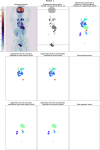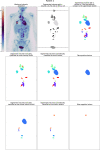Automatic classification of lymphoma lesions in FDG-PET-Differentiation between tumor and non-tumor uptake
- PMID: 35436321
- PMCID: PMC9015138
- DOI: 10.1371/journal.pone.0267275
Automatic classification of lymphoma lesions in FDG-PET-Differentiation between tumor and non-tumor uptake
Abstract
Introduction: The automatic classification of lymphoma lesions in PET is a main topic of ongoing research. An automatic algorithm would enable the swift evaluation of PET parameters, like texture and heterogeneity markers, concerning their prognostic value for patients outcome in large datasets. Moreover, the determination of the metabolic tumor volume would be facilitated. The aim of our study was the development and evaluation of an automatic algorithm for segmentation and classification of lymphoma lesions in PET.
Methods: Pre-treatment PET scans from 60 Hodgkin lymphoma patients from the EuroNet-PHL-C1 trial were evaluated. A watershed algorithm was used for segmentation. For standardization of the scan length, an automatic cropping algorithm was developed. All segmented volumes were manually classified into one of 14 categories. The random forest method and a nested cross-validation was used for automatic classification and evaluation.
Results: Overall, 853 volumes were segmented and classified. 203/246 tumor lesions and 554/607 non-tumor volumes were classified correctly by the automatic algorithm, corresponding to a sensitivity, a specificity, a positive and a negative predictive value of 83%, 91%, 79% and 93%. In 44/60 (73%) patients, all tumor lesions were correctly classified. In ten out of the 16 patients with misclassified tumor lesions, only one false-negative tumor lesion occurred. The automatic classification of focal gastrointestinal uptake, brown fat tissue and composed volumes consisting of more than one tissue was challenging.
Conclusion: Our algorithm, trained on a small number of patients and on PET information only, showed a good performance and is suitable for automatic lymphoma classification.
Conflict of interest statement
The authors have declared that no competing interests exist.
Figures
References
Publication types
MeSH terms
Substances
LinkOut - more resources
Full Text Sources
Medical




